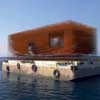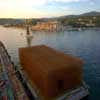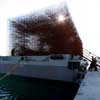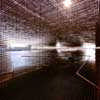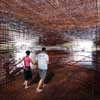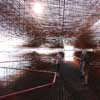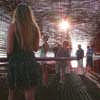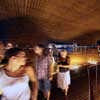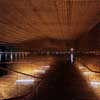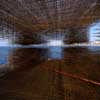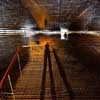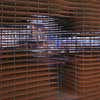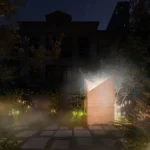Venice Architecture Biennale Croatian Pavilion 2010, Images, Floating Design, Photos
Venice Biennale 2010 Croatian Pavilion : Architecture
The Ship, Italy
24 Aug 2010
Venice Biennale Croatian Pavilion
A project of the Ministry of Culture, Republic of Croatia
Bozo Biskupic, Minister of Culture
La Biennale di Venezia
12. Mostra Internationale di Architettura
12th International Architecture Exhibition
Croatian Pavilion
Brod / The Ship / La Nave: A Floating Pavilion for Croatia at the Venice Biennale
Time Schedulefor August 28th 2010:
8:00 AM – 10:00 AM, Towing through Venice Lagoon to the Riva dei Sette Martiri
10:00 AM – Aug. 29th 06:00 PM, Mooring at the Riva dei Sette Martiri
2:30 PM, Croatian Venue exhibition opening in Arsenale
6:30 PM, Inauguration and opening of the Croatian Floating Pavilion at the Riva dei Sette Martiri
Commissioner: Leo Modrcin
Participating architects:
Sasa Begovic, Marko Dabrovic, Igor Franic, Tanja Grozdanic, Petar Miskovic, Silvije Novak, Veljko Oluic, Helena Paver Njiric, Lea Pelivan, Toma Plejic, Goran Rako, Sasa Randic, Idis Turato, Pero Vukovic, Tonci Zarnic
Organizer: Museum of Modern and Contemporary Art, Rijeka, Croatia
Brod / The Ship / La Nave: A Floating Pavilion for Croatia at the Venice Biennale
The Floating Pavilion to present arts and architecture of Croatia at the Venice Biennale is constructed on an existing barge with dimensions of 10m x 20m x 3m. It is designed by a group of 14 leading Croatian architects, who have made the recent Croatian architecture visible on the global scene. Instead of working in the usual formats of their practices and presenting speculative projects, they decided to work together on a single proposal and to have it constructed and towed toward its final destination in Venice right away.
The pavilion structure is the barge’s cargo, welded from 30 tons of Q385 wire mesh in more than 40 layers of varying contours. The cargo presented here maps the process of intense interaction between architects working on the common project, their collaboration with the Croatian maritime industry, and the extraordinary act of architecture it produced. Please follow the pavilion’s maiden voyage across the Adriatic at www.pavilion.hr.
La Biennale di Venezia 2010 12
Mostra Internazionale di Architettura 12th International Architecture Exhibition
Croatian participation at the 12th International Architecture Exhibition at la Biennale di Venezia consists of three components: a floating pavilion, the exhibition of the project at the Croatian venue at the Arsenale, and a publication of the project distributed to visitors at the venue.
The Pavilion
The Floating Pavilion is built on an existing barge with dimensions of 10m x 20m x 3m. The pavilion structure is in the form of a cargo of 32 tons of welded wire mesh, with more than 40 layers spaced so that they form a solid volume with approximate dimensions of 19m x 9m x 5,5m.
Inside the volume is a carved out space shaped by varying contours that form the main space as well as protrusions and openings toward the outside. Almost invisible form a distance, the structure reveals itself with different densities of steel mesh, transparencies, and vision lines, forming stunning visual effects and experience of space by very simple means. The Croatian pavilion is towed by a tugboat from the shipyard in Kraljevica to the port of Rijeka, to be presented to the public on 21 August 2010, and on to Venice to be moored at the main pier during the opening of the Biennale.
The Exhibition
Inside the Croatian exhibition space, the project documentation center has been set up in the form of cargo boxes printed with the records of the design process, the construction of the pavilion at the 280-year-old shipyard in Kraljevica, and its journey across the Adriatic. Lana Cavar and Narcisa Vukojević are responsible for graphic design of the exhibition, while Vjeran Šalomon made audio installation.
The Publication
Also as cargo, the project publication is presented in the form of 6 loose printed sheets with photo documentation, which when folded and bound make a 96 page book for everybody to take. The concept and the production of the publication is by Lana Cavar and Narcisa Vukojević. Marko Golub conducted the interviews.
The Authors
The authors of the project are 15 of the most distinguished Croatian architects of today, who through various practices and some of the most distinct buildings designed recently, are already recognized on the global architectural scene. They have established Croatian architecture as a relevant force. Here they have united into a single work team that has produced a common project and had it realized for the Croatian participation at La Biennale.
Saša Begović, Marko Dabrović, Igor Franić,Tanja Grozdanić, Petar Mišković,Silvije Novak, Veljko Oluić, Helena Paver Njirić, Lea Pelivan, Toma Plejić,Goran Rako, Saša Randić, Idis Turato, Pero Vuković and Tonči Žarnić met in more than 20 work sessions and innumerable other meetings and site visits.
The Commissioner
The Commissioner Leo Modrčin proposed the pavilion on a barge as a simple solution for Croatia’s need for space at the Venice Biennale and as a symposium of multiple ideas and projects to be exhibited at la Biennale. Instead, he found himself moderating the rare and dramatic process of architectural teamwork and construction, which resulted in a singular and most inspiring work of architecture.
The Support
Besides the Croatian Ministry of Culture, which generously accepted all the uncertainties of the design and building process, the project is supported by the organizer, the Museum of Modern and Contemporary Art in Rijeka, the Croatian port city where most of the maritime and shipbuilding industries and services supporting the project are based. The main sponsors are Shipyard Kraljevica/fabrication, 3.maj Shipyard Rijeka/barge and Jadranski pomorski servis/towing. AVC Zagreb provides exhibition support.
The Commissioner’s Statement / from the book’s introduction
At the point of this writing, it is still uncertain when the pavilion will reach Venice after touching the homeports on the Croatian coast of the Adriatic. Not to accomplish the full circle and reach the final destination after this extraordinary effort by its creators and the numerous members of the local maritime industry would be simply wrong.
In our usual ways of architectural spin masters, we could justify the process of design itself without the final materialization as a valid and as the most literal of responses to the theme proposed by Ms. Sejima. It is a meeting of great architectural minds, completely realized as accomplished architects, who have accepted the uncertainty of the unusual project and now generously share this profound personal experience of working in an unstable group setting with the general public.
Yet, without the actual construction and navigation to Venice, we would have never been able to gather all the parameters of the project and prove the feasibility of the whole premise that a floating pavilion was a possible way to go. For this group of architects there was simply no alternative. The construction on the barge has been a monumental task in itself. Designed by 14 authors, it is fabricated by a dozen welders who put in a countless number of welds in order to build the structure.
It consists of 42 layers of Q385 weeded wire mesh put together by welding each layer on vertical rods spaced 50 cm in either direction. It is a fragile construction despite the 32 tons of steel, perhaps just a fraction of material expected to conquer such a volume of space. The solid part is everything but solid and it fully disappears when viewed from a distance, only to reappear as a heavy shield of steel when inside. Entering it somehow feels like entering a wire frame drawing, a raw armature of space before it is rendered into a full glory of a simulated, complete rendering of architecture. But here you are the rendering device. This must be architecture.
And you want to meet in it and share it. Especially when the 32 tons of welded wire mesh start shimmering as the waves bounce the entire structure as if it were a gull feather in the breeze. Some might try to prove it wrong to think that it is appropriate for an art and architecture pavilion to be a bit shaky, unstable, and even dangerous at times.
But I am saying without any hesitation that the group of Croatian architects has produced an exceptional work of architecture. As it leaves the shipyard, it only now starts unloading its meanings, problems, beauty, truths, inspirations, and aspirations. Please follow its maiden voyage at www.pavilion.hr
Participants’ Biographies + Credits
Venice Biennale Croatia Pavilion
Location: Venice, Italy
Venice Architecture
Venice Architecture Designs – chronological list
Venice Architecture Tours by e-architect
Venice Architecture Biennale 2010, Exhibit
Venice Architecture Biennale Danish Pavilion 2010 : Exhibition
Venice Biennale landscape installation by Gustafson Porter
Venice Biennale exhibition Dune Formations installation 2007, Scuola dei Mercanti
Venice Biennale Installation : Dune Formations images by Zaha Hadid
Comments / photos for the Venice Biennale 2010 Croatian Pavilion page welcome


